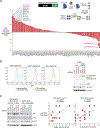A novel model of alternative NF-κB pathway activation in anaplastic large cell lymphoma
- PMID: 33184494
- PMCID: PMC9245089
- DOI: 10.1038/s41375-020-01088-y
A novel model of alternative NF-κB pathway activation in anaplastic large cell lymphoma
Abstract
Aberrant activation of NF-κB is the most striking oncogenic mechanism in B-cell lymphoma; however, its role in anaplastic large cell lymphomas (ALCL) has not been fully established and its activation mechanism(s) remain unclear. Using ALCL cell line models, we revealed the supporting roles for NFKB2 and the NIK pathway in some ALCL lines. To investigate the detailed activation mechanisms for this oncogenic pathway, we performed specifically designed alternative NF-κB reporter CRISPR screens followed by the RNA-seq analysis, which led us to identify STAT3 as the major mediator for NIK-dependent NF-κB activation in ALCL. Consistently, p-STAT3 level was correlated with NFKB2 nuclear accumulation in primary clinical samples. Mechanistically, we found that in NIK-positive ALK- ALCL cells, common JAK/STAT3 mutations promote transcriptional activity of STAT3 which directly regulates NFKB2 and CD30 expression. Endogenous expression of CD30 induces constitutive NF-κB activation through binding and degrading of TRAF3. In ALK+ ALCL, the CD30 pathway is blocked by the NPM-ALK oncoprotein, but STAT3 activity and resultant NFKB2 expression can still be induced by NPM-ALK, leading to minimal alternative NF-κB activation. Our data suggest combined NIK and JAK inhibitor therapy could benefit patients with NIK-positive ALK- ALCL carrying JAK/STAT3 somatic mutations.
Conflict of interest statement
Conflicts of Interest.
The authors declare no competing financial interests.
Figures







Similar articles
-
Cytokine receptor signaling is required for the survival of ALK- anaplastic large cell lymphoma, even in the presence of JAK1/STAT3 mutations.Proc Natl Acad Sci U S A. 2017 Apr 11;114(15):3975-3980. doi: 10.1073/pnas.1700682114. Epub 2017 Mar 29. Proc Natl Acad Sci U S A. 2017. PMID: 28356514 Free PMC article.
-
The NPM-ALK oncoprotein abrogates CD30 signaling and constitutive NF-kappaB activation in anaplastic large cell lymphoma.Cancer Cell. 2004 Apr;5(4):353-64. doi: 10.1016/s1535-6108(04)00084-4. Cancer Cell. 2004. PMID: 15093542
-
STAT3 couples activated tyrosine kinase signaling to the oncogenic core transcriptional regulatory circuitry of anaplastic large cell lymphoma.Cell Rep Med. 2024 Mar 19;5(3):101472. doi: 10.1016/j.xcrm.2024.101472. Cell Rep Med. 2024. PMID: 38508140 Free PMC article.
-
Molecular Insights into the Diagnosis of Anaplastic Large Cell Lymphoma: Beyond Morphology and Immunophenotype.Int J Mol Sci. 2025 Jun 19;26(12):5871. doi: 10.3390/ijms26125871. Int J Mol Sci. 2025. PMID: 40565334 Free PMC article. Review.
-
Cellular and Molecular Mechanisms of Breast Implant-Associated Anaplastic Large Cell Lymphoma.Plast Reconstr Surg. 2021 Jan 1;147(1):30e-41e. doi: 10.1097/PRS.0000000000007423. Plast Reconstr Surg. 2021. PMID: 33370049 Review.
Cited by
-
Fusion transcripts FYN-TRAF3IP2 and KHDRBS1-LCK hijack T cell receptor signaling in peripheral T-cell lymphoma, not otherwise specified.Nat Commun. 2021 Jun 17;12(1):3705. doi: 10.1038/s41467-021-24037-4. Nat Commun. 2021. PMID: 34140493 Free PMC article.
-
P-Glycoprotein as a Therapeutic Target in Hematological Malignancies: A Challenge to Overcome.Int J Mol Sci. 2025 May 14;26(10):4701. doi: 10.3390/ijms26104701. Int J Mol Sci. 2025. PMID: 40429842 Free PMC article. Review.
-
Genetic and immunohistochemical profiling of NK/T-cell lymphomas reveals prognostically relevant BCOR-MYC association.Blood Adv. 2023 Jan 10;7(1):178-189. doi: 10.1182/bloodadvances.2022007541. Blood Adv. 2023. PMID: 35882439 Free PMC article.
-
Analysis and therapeutic targeting of the IL-1R pathway in anaplastic large cell lymphoma.Blood. 2023 Oct 12;142(15):1297-1311. doi: 10.1182/blood.2022019166. Blood. 2023. PMID: 37339580 Free PMC article.
-
Bone Marrow CD34+/lin- Cells of Patients with Chronic-Phase Chronic Myeloid Leukemia (CP-CML) After 12 Months of Nilotinib Treatment Exhibit a Different Gene Expression Signature Compared to the Diagnosis and the Corresponding Cells from Healthy Subjects.Cancers (Basel). 2025 Mar 18;17(6):1022. doi: 10.3390/cancers17061022. Cancers (Basel). 2025. PMID: 40149355 Free PMC article.
References
-
- Morris SW, Kirstein MN, Valentine MB, Dittmer KG, Shapiro DN, Saltman DL, et al. Fusion of a kinase gene, ALK, to a nucleolar protein gene, NPM, in non-Hodgkin’s lymphoma. Science 1994. Mar 4; 263(5151): 1281–1284. - PubMed
-
- Shiota M, Fujimoto J, Semba T, Satoh H, Yamamoto T, Mori S. Hyperphosphorylation of a novel 80 kDa protein-tyrosine kinase similar to Ltk in a human Ki-1 lymphoma cell line, AMS3. Oncogene 1994. Jun; 9(6): 1567–1574. - PubMed
-
- Kempf W CD30+ lymphoproliferative disorders: histopathology, differential diagnosis, new variants, and simulators. J Cutan Pathol 2006. Feb; 33 Suppl 1: 58–70. - PubMed
Publication types
MeSH terms
Substances
Grants and funding
LinkOut - more resources
Full Text Sources
Research Materials
Miscellaneous

